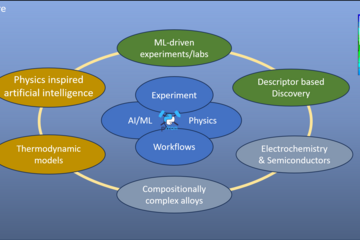All genres
11241.
Teaching
Korrosion keramischer Werkstoffe. Lecture: Vorlesung WS 2005/2006, RWTH Aachen, Germany
11242.
Teaching
Werkstoffkundliche Exkursionen. Lecture: Veranstaltung SS 2006, Ruhr-Universität-Bochum (Fakultät für Maschinenbau), Germany
11243.
Thesis
Untersuchung des Einflusses definierter Schmierverhältnisse am Beispiel des Flachstauchversuches. TU, Clausthal, Germany (2002)
11244.
Thesis - PhD
Effect of grain boundary atomic structure on shear coupled grain boundary motion in copper using atomistic simulation. Dissertation, Ruhr-Universität Bochum, Bochum, Germany (2025)
11245.
Thesis - PhD
Design of ZrCu thin film metallic glasses with tailored mechanical properties through control of composition and nanostructure. Dissertation, RUB Bochum, Bochum, Germany (2025)
11246.
Thesis - PhD
Development of an ab initio electrochemical cell: Understanding the dielectric properties of interfacial water and Mg dissolution from first principles. Dissertation, Philipps-Universität Marburg, Germany (2024)
11247.
Thesis - PhD
Dislocation transmission through coherent and incoherent twin boundaries in copper at the micron scale. Dissertation, Ruhr University Bochum (2024)
11248.
Thesis - PhD
Investigation of Key Parameters in Cathodic Delamination of Organic Coatings and Quantification of Their Role. Dissertation, Ruhr-Univesität Bochum, Fakultät Maschinenbau (2023)
11249.
Thesis - PhD
Influence of plastic anisotropy on the deformation behaviour of Austenitic stainless-steel during single micro-asperity wear. Dissertation, Ruhr-Uiversität-Bochum (2023)
11250.
Thesis - PhD
Hydrogen effects on the mechanical behaviour of FeCr alloys investigated by in-situ nanoindentation. Dissertation, Ruhr-Universität Bochum (2023)
11251.
Thesis - PhD
Effect of grain boundary phases on the thermoelectric properties of half Heusler materials. Dissertation, Ruhr-Universität Bochum (2023)
11252.
Thesis - PhD
Critical assessment and investigation of the Ti-Al-X (X = Si, Zr, O) systems. Dissertation, Ruhr-Universität Bochum (2023)
11253.
Thesis - PhD
Elektrochemie von "trockenen" Metalloberflächen im Hinblick auf atmosphärische Korrosion. Dissertation, Ruhr-Universität Bochum (2023)
11254.
Thesis - PhD
Phase identification and micromechanical characterization of an advanced high-strength low-alloy steel. Dissertation, Ruhr-Universität Bochum (2023)
11255.
Thesis - PhD
Fundamental investigation of the atomic structures of [111] tilt grain boundaries, their defects and segregation behaviour in pure and alloyed Al. Dissertation, Ruhr-Universität Bochum (2023)
11256.
Thesis - PhD
Influence of Structure and Topology on the Deformation Behavior and Fracture of Oxide Glasses. Dissertation, Friedrich-Alexander-Universität Erlangen-Nürnberg (FAU) (2023)
11257.
Thesis - PhD
On the cementite behavior during tribology and experimental methods of microscale wear. Dissertation, Ruhr-Universität Bochum (2022)
11258.
Thesis - PhD
Microstructure and grain boundary evolution in titanium thin films. Dissertation, Ruhr-Universität Bochum (2022)
11259.
Thesis - PhD
Atomic-scale characterisation of grain boundary structure and segregation in bcc-iron. Dissertation, Ruhr-Universität Bochum (2022)
11260.
Thesis - PhD
Critical factors for bearing failures by localized severe plastic deformation. Dissertation, RWTH Aachen, Germany (2022)


